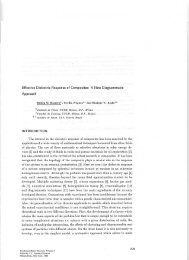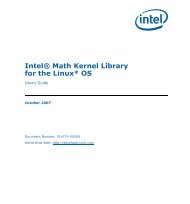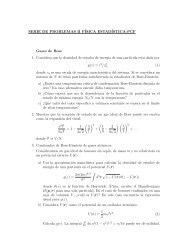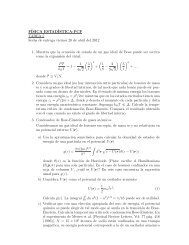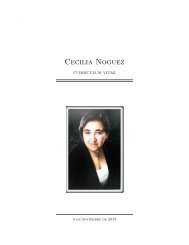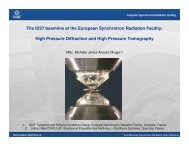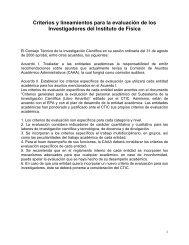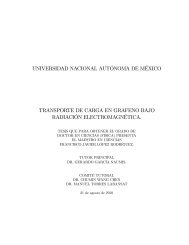Surface Plasmons on Metal Nanoparticles - UNAM
Surface Plasmons on Metal Nanoparticles - UNAM
Surface Plasmons on Metal Nanoparticles - UNAM
You also want an ePaper? Increase the reach of your titles
YUMPU automatically turns print PDFs into web optimized ePapers that Google loves.
3818 J. Phys. Chem. C, Vol. 111, No. 10, 2007 Noguezres<strong>on</strong>ances are observed <strong>on</strong>ly at f ) 0.8, whereas for disorderB, shown in Figure 12c, the multipolar character is evident atany filling fracti<strong>on</strong>. Notice that for larger filling fracti<strong>on</strong>s andgreater disorder the dipolar character of the res<strong>on</strong>ant mode islost.In c<strong>on</strong>clusi<strong>on</strong>, we found that as the filling fracti<strong>on</strong> increases,more multipolar interacti<strong>on</strong>s are present, for all the positi<strong>on</strong>alarrangements. As the positi<strong>on</strong>al disorder increases, it alsoinduces the excitati<strong>on</strong> of new multipolar c<strong>on</strong>tributi<strong>on</strong>s. It seemsthat the spectrum becomes wider as there is more “room’’ fordisorder. As a c<strong>on</strong>sequence, the inclusi<strong>on</strong> of these multipolarmodes shifts the main peak to higher (lower) wavelengths andincreases the extensi<strong>on</strong> of the tail in the low (high)-wavelengthside, for an external field parallel (transversal) to the chain. Butthe most interesting thing is that there is not <strong>on</strong>ly a red shift ofthe peaks but also a drastic change in the profile. Furthermore,it was found that, due to the symmetry of the system, there isno coupling between the directi<strong>on</strong>s parallel and transversal tothe chain. This means that an external field parallel to the chainwill induce multipoles in each sphere, with an axis of symmetryalso parallel to the chain, but they will fluctuate in magnitudeand phase. These fluctuati<strong>on</strong>s cause the existence of a manifoldof collective modes with a c<strong>on</strong>tinue range of res<strong>on</strong>ant frequencies.VII. Summary and Future TrendsWe have studied the general behavior of the surface plasm<strong>on</strong>res<strong>on</strong>ances <strong>on</strong> small metal NPs in terms of their shape andphysical envir<strong>on</strong>ment. For instance, the locati<strong>on</strong> of theseres<strong>on</strong>ances <strong>on</strong> NPs of different shapes has been studied andhas been found that NPs with fewer faces and sharper verticesshow res<strong>on</strong>ances in a wider range of wavelengths. We alsoshowed that, when a NP is truncated, the main res<strong>on</strong>ance isblue-shifted, overlapping sec<strong>on</strong>dary res<strong>on</strong>ances and, therefore,increasing the full width at half-maximum. However, fordecahedral particles, the truncati<strong>on</strong> to Marks and roundeddecahedra shows the same blue shift effect, but the full widthat half-maximum decreases, perhaps because the sec<strong>on</strong>daryres<strong>on</strong>ances no l<strong>on</strong>ger exist as the number of faces increases.We also explained in detail the optical anisotropy of el<strong>on</strong>gatedNPs, such as, ellipsoids, decahedra, etc., where the dependenceof the positi<strong>on</strong> of the res<strong>on</strong>ances is analytically explained interms of their aspect ratio.We have analyzed the case where n<strong>on</strong>interacting el<strong>on</strong>gatedNPs are aligned in a given directi<strong>on</strong>, such that, the opticalresp<strong>on</strong>se can be tuned using polarized light and changing theaspect ratio. We also studied the case of a linear chain ofinteracting NPs, where again, the surface plasm<strong>on</strong> res<strong>on</strong>ancesare sensitive to the light polarizati<strong>on</strong>, and their dependence withthe positi<strong>on</strong>al disorder of the particles. This 1D nanostructurescan be the starting point for more complex structures. Finally,the case of supported NPs was also studied. In this case, theline-shape of the spectra, and its relati<strong>on</strong> with high-multipolarexcitati<strong>on</strong>, is studied in detailed for ellipsoidal NPs. The opticalresp<strong>on</strong>se is studied for different physical situati<strong>on</strong>s: as a functi<strong>on</strong>of the distance between the particle and substrate, as well as interms of the anisotropy of the particle.This informati<strong>on</strong> would be useful to motivate the developmentof more complex nanostructures with tunable surface plasm<strong>on</strong>res<strong>on</strong>ances. For this, it would be desirable to develop a simpletheory capable of predicting the positi<strong>on</strong> and strength of theSPRs of an ample variety of NPs shapes and physical envir<strong>on</strong>ments.We have already menti<strong>on</strong>ed that the spectral representati<strong>on</strong>formalism completes with these characteristics, because itseparates the c<strong>on</strong>tributi<strong>on</strong> of the dielectric properties from thegeometrical <strong>on</strong>es. We have shown the potentiality of this theory,that allows us to perform a systematic study of the opticalresp<strong>on</strong>se of NPs, <strong>on</strong>ce a shape is chosen. However, explicitexpressi<strong>on</strong>s of the spectral representati<strong>on</strong> are difficult to obtain,but alternative forms could be found.Acknowledgment. I am in debt to my many colleagues andstudents that have c<strong>on</strong>tributed al<strong>on</strong>g these years to the study ofthe optical resp<strong>on</strong>se <strong>on</strong> nanoparticles. In particular, I would liketo acknowledge Professor Rubén G. Barrera and Dr. Carlos E.Román for their illuminating c<strong>on</strong>tributi<strong>on</strong>s in spectral representati<strong>on</strong>formalism and substrate effects. I also want toacknowledge the c<strong>on</strong>tributi<strong>on</strong> of Ana Lilia G<strong>on</strong>zález in the studyof the polyhedral particles. Partial financial support fromCONACyT Grant Nos. 48521-F and 44306-F and DGAPA-<strong>UNAM</strong> Grant No. IN101605 is also acknowledged.References and Notes(1) Noguez, C.; Román-Velázquez, C. E. Phys. ReV. B 2004, 70,195412.(2) Intravaia, F.; Lambrecht, A. Phys. ReV. Lett. 2005, 94, 110404.(3) Xu, H.; Käll, M. Phys. ReV. Lett. 2002, 89, 2468021.(4) Ozbay, E. Science 2006, 331, 189.(5) Maier, S. A.; Kik, P. G.; Atwater, H. A.; Meltzer, S.; Harel, E.;Koel, B. E.; Requicha, A. A. G. Nat. Mat. 2003, 2, 229.(6) Maier, S. A.; Atwater, H. A. J. Appl. Phys. 2005, 98, 011101.(7) Zhang, Y.; Gu, C.; Schwartzberg, A.; Chen, S.; Zhang, J. Z. Phys.ReV. B2006, 73, 1654051.(8) Haynes, C. L.; McFarland, A. D.; Van Duyne, R. P. Anal. Chem.2005, 77, 338A.(9) Jin, R.; Cao, Y.; Mirkin, C. A.; Kelly, K. L.; Schatz, G. C.; Zheng,J.-G. Science 2001, 294, 1901.(10) Jin, R.; Cao, Y. C.; Hao, E.; Métraux, G. S.; Schatz, G. C.; Mirkin,C. A. Nature 2003, 425, 487.(11) Sönnichsen, C.; Reinhard, B. M.; Liphardt, J.; Alivisatos, A. P.Nat. Biotechnol. 2005, 33, 741.(12) Hibbins, A. P.; Evans, B. R.; Sambles, J. R. Science 2005, 308,670.(13) Liz-Marzán,L.M.Langmuir 2006, 22, 32.(14) Barnes, W. L.; Dereux, A.; Ebbesen, T. W. Nature 2003, 424, 824.(15) Huang, X.; El-Sayed, I. H.; Qian, W.; El-Sayed, M. A. J. Am. Chem.Soc. 2006, 128, 2115.(16) Kelly, K. L.; Cor<strong>on</strong>ado, E.; Zhao, L. L.; Schatz, G. C. J. Phys.Chem. B 2003, 107, 668.(17) Sosa, I. O.; Noguez, C.; Barrera, R. G. J. Phys. Chem. B 2003,107, 6269.(18) Noguez, C. Opt. Mat. 2005, 27, 1204.(19) Payne, E. K.; Shuford, K. L.; Park, S.; Schatz, G. C.; Mirkin, C.A. J. Phys. Chem. B 2006, 110, 2150.(20) Lee, K.-S.; El-Sayed, M. A. J. Phys. Chem. B 2005, 109, 20331.(21) Wang, Z. L. J. Phys. Chem. B 2000, 104, 1153.(22) Yacamán, M. J.; Ascencio, J. A.; Liu, H. B.; Gardea-Torresdey, J.J. Vac. Sci. Technol. B 2001, 19, 1091.(23) Yang, C. Y. J. Cryst. Growth 1979, 47, 274.(24) Kuo, C.-H.; Chiang, T.-F.; Chen, L.-J.; Huang, M. H. Langmuir2004, 20, 7820.(25) Wei, G.; Zhou, H.; Liu, Z.; S<strong>on</strong>g, Y.; Wang, L.; Sun, L.; Li, Z. J.Phys. Chem. B 2005, 109, 8738.(26) Nilius, N.; Ernst, N.; Freund, H.-J. Phys. ReV. Lett. 2000, 84, 3994.(27) G<strong>on</strong>zalez, A. L.; Noguez, C.; Ortiz, G. P.; Rodriguez-Gattorno, G.J. Phys. Chem. B 2005, 109, 17512.(28) Tao, A.; Sinsermsuksakul, P.; Yang, P. Angew. Chem., Int. Ed.2006, 45, 4597.(29) Baletto, F.; Ferrando, R. ReV. Mod. Phys. 2005, 77, 371.(30) Barnard, A. S.; Lin, X. M.; Curtiss, L. A. J. Phys. Chem. B 2005,109, 24465.(31) Román-Velázquez, C. E.; Noguez, C.; Garzón,I.L.J. Phys. Chem.B 2003, 107, 12035.(32) Sánchez-Castillo, A.; Román, Velázquez, C. E.; Noguez, C. Phys.ReV. B2006, 73, 045401.(33) Yao, H.; Miki, K.; Nishida, N.; Sasaki, A.; Kimura, K. J. Am. Chem.Soc. 2005, 127, 15536.(34) Negishi, Y.; Nobusada, K.; Tsukuda, T. J. Am. Chem. Soc. 2005,127, 5261.(35) Nobusada, K. J. Phys. Chem. B 2004, 108, 11904.




